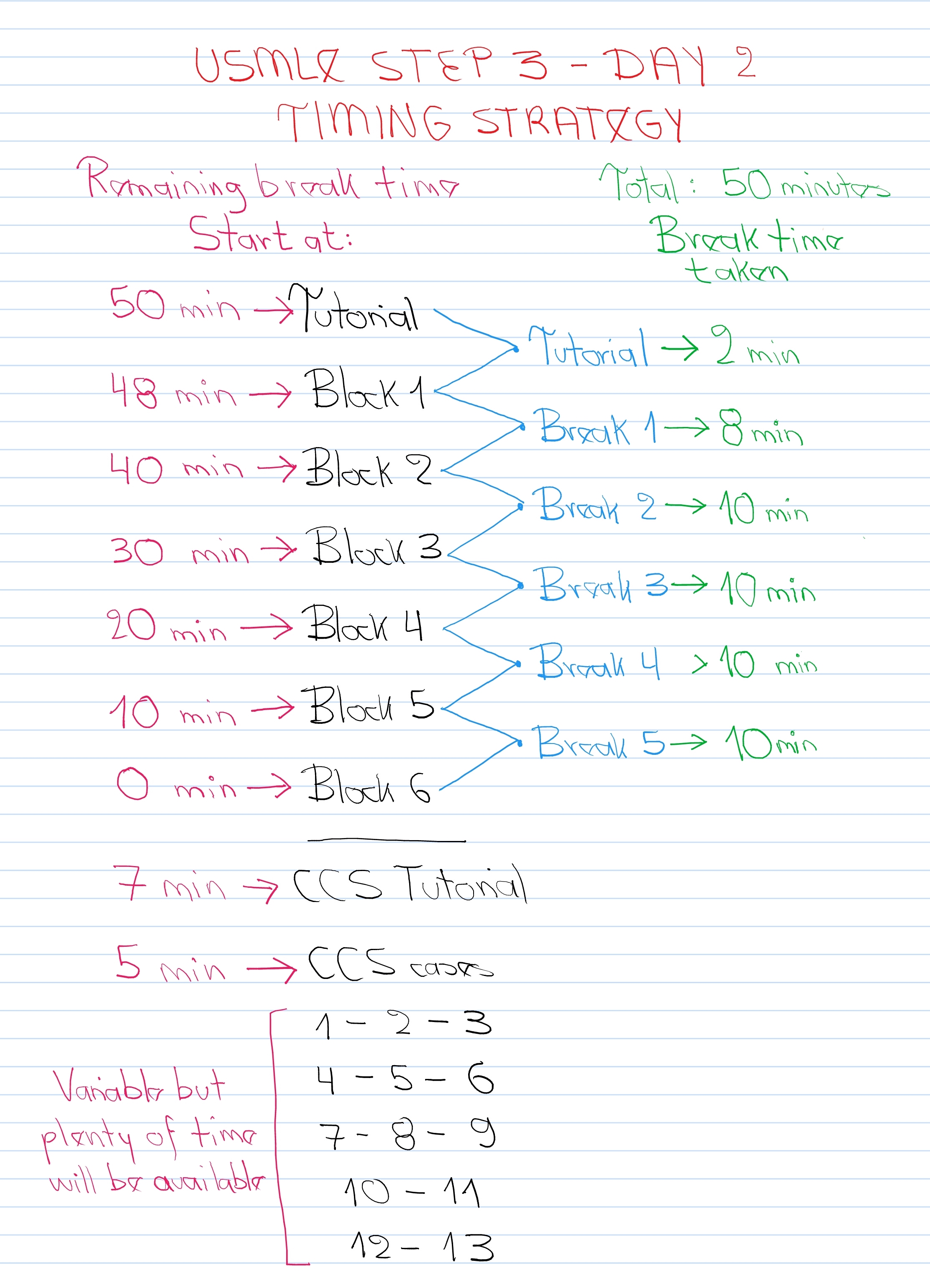The USMLE Step 3 exam is the final step of the USMLE examination series. It is a two-day examination which consists essentially of multiple choice questions and Computer-Based Case Simulations (CCS). It is very important to get familiar with the exam format since every day has its own characteristics. Furthermore, a precise time management strategy as will be described in this post “USMLE Step 3 Exam Timing Strategy” is crucial.
Please, be sure to review all the important information about the USMLE Step 3 exam using the following link:
For instance, the first day consists of 233 multiple-choice items divided into 6 blocks of 38-40 questions; with 60 minutes provided to complete each block. The total approximate duration of the day is 7 hours. It is not as long as the Step 2 CK exam (9-hour long test) but it is challenging as well. It is called the “Foundations of Independent Practice (FIP) session because it assesses the basic medical and scientific principles for effective healthcare practice in an independent environment. Biostatistics, epidemiology and population health, interpretation of the medical literature (That’s right! With the Abstract and Drug Ad questions that we all love!), application of social sciences, medical ethics, systems-based practice, patient safety, and related topics are covered during this day. Although it is variable from one person to another, this is usually the most difficult day of the entire exam. Be prepared to have a Drug Ad or Abstract question in every block, with tons of other epidemiology/biostatistics questions as well.
In the other hand, the second day is a 9-hour long test session that includes 180 multiple-choice items, divided into 6 blocks of 30 items with 45 minutes allotted to complete each block. There is an optional 5 minute tutorial for the multiple-choice items part (at the beginning of the test). The second part of the day includes a 7-minute CCS tutorial (second tutorial of the day). Then there are 13 case simulations and each of them can have a duration of 10 or 20 minutes. A minimum of 45 minutes is available for break time for the entire day, and it is possible to skip both tutorials and add 5 + 7 minutes to the break time. The timing strategy will be discussed soon, and it will get easier to understand. There is an optional survey at the end of the second day, which can be completed if time allows. It is also called the Advanced Clinical Medicine (ACM) part and is related mostly to the assessment of knowledge of diagnosis and patient management, prognosis and outcome, health maintenance and screening, therapeutics, and medical decision making.
In summary:
- The first day consists of:
- Tutorial: 5 minutes.
- 6 blocks of 38-40 questions: 60 minutes for each block.
- Break time: 45 minutes. Can be 50 minutes if the tutorial is completely skipped.
- The second day consists of:
- Tutorial 1: 5 minutes.
- Part 1: 6 blocks of 30 questions: 45 minutes for each block.
- Tutorial 2: 7 minutes.
- Part 2: 13 CCS cases: 10 or 20 minutes for each case.
- Break time (for the entire day): 45 minutes. Can be 50 minutes if the tutorial is skipped.
There are a few considerations to keep in mind:
- During the first day, the blocks can be longer and more difficult than during the second day. Therefore, the tutorial time is very rigid. 50 minutes. That is it.
- The second day is flexible regarding break time. The major reason for this is that the CCS cases usually finish early (mostly the 20 minute-long cases). The time not taken for finishing the cases will be automatically assigned to the break time.
Personally, when I took my exam, I used the entire 50 minutes of break time entirely for the first part of the test only (multiple choice questions) and started the CCS part without break time. Then I used the 7-minute tutorial as the starter time for my breaks in the CCS section. However, I had plenty of time to do the CCS section in a relaxed manner. There is no need to rush in the CCS section. The bottom line is that the CCS part gives you enough time for break even if you took all the break time for the multiple-choice questions part.
- The CCS cases have a 1-minute start screen that is NOT counted as part of the 10 or 20 minutes of each case (That is a free minute per case!). That minute can be skipped as well, and that time is immediately assigned for the break time.
- You can finish an hour before or even more of the 9 hours assigned for the test depending on how fast your CCS cases advance, and how many breaks you decide to take.
USMLE STEP 3 EXAM TIMING STRATEGY
TIMING STRATEGY FOR THE FIRST DAY:
The timing strategy is mostly oriented to an efficient break time structure. Therefore, in the previous image, the first column on your left (red column) is the most important since it portrays the break time available from the beginning until the end of your test day. The concept is to write down this column in the notes sheet provided by Prometric so that you know exactly when you will start each block. For example, the tutorial starts at 50 minutes, then you can take two minutes to skip the tutorial and begin the first block at 48 minutes. The same will continue forward for the rest of the blocks, with the last block (Block 6) starting at 0 minutes which means that you will have used all your break time efficiently to rest between the blocks of questions. The timing strategy in the first day is simple.
TIMING STRATEGY FOR THE SECOND DAY:
The second day can be a little difficult to understand. However, it is actually more flexible than the first day regarding break times. The first part of multiple-choice questions is exactly the same structure of the first day as it can be interpreted in the left column in the previous image. The second part of the exam is the CCS section. There are 13 cases that can be 10 or 20 minutes long. Even if you go slow during the cases, most of them will still give you free time for your breaks. if you skip the start screen of each case, that will give you a minute per every block for your break time; thus 13 minutes for break time are available from these start screens. There is more than enough time for the CCS section. The strategy for the CCS cases can be done as proposed in the previous image. Take 3 cases in a row and then take a break. Continue doing this for the first 9 cases, and then to avoid exhaustion, take 2 cases followed by the last break and finish the last two cases. This is an example of how it can be done, but the good news is that you can take breaks anytime between the cases.
Finally, after finishing the last CCS case, there is an optional survey at the end of the test. That concludes the explanation of the structure and strategy for the USMLE Step 3 exam. The structure can be adapted to the needs of the test taker. This is an example of a real strategy used and proven (by me). The USMLE Step 3 exam is a challenging but amazing experience, and it can be lived just once in your life; therefore, although it can be stressful, try to enjoy it as a big step in your career. Thank you for reading. If you have a comment or question you would like to ask, please, do so in the comments section below.
Good luck with your exam.
- Aortic Stenosis Severity Classification - 09/22/2020
- Carboplatin (Paraplatin) - 04/07/2019
- How to test for Vitamin D deficiency? - 09/29/2018






Thanks! this post is just what I needed to guide my exam strategy
Thank you Pedro. I am so glad to hear!
Thank you! This is very helpful!
You’re welcome. I am happy to know that! Good luck!
Thank you very much!! Exactly what i was looking for
Amazing Mani! Thank you for your comment
This is precisely what I was looking for. Thanks so much!
Thank you Greg. Good luck!
Your articles for step 1, 2 and 3 have been the BEST resources for timing and strategy! Thank you so much for sharing! Forever grateful!
Thank you very much for your comment. I am glad to hear! =)